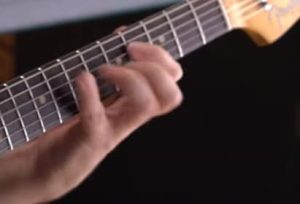Recently, I was browsing a guitar forum (yes, my life is that exciting) and ran across the most ridiculous post (I thought). This dude was talking about the fretting hand thumb position for guitar players.
I'm always on the lookout for something that can make me a better musician.
Open Chord Position
Conventional wisdom is that there are two main thumb positions for your fretting hand. If you're playing chords in the open position (you know, like a D chord), your thumb might be up over the top of the neck, or even wrapped around, playing that F#.

Playing a D chord in open position
In this position, the first joint of your index finger (where the finger meets the hand) presses against the bottom of the neck.
A similar position is also good for bending notes during lead playing. It's not a good hand position for long stretches, though. And, I really need to dust off my headstock (that's not a euphemism).
'Classical' Hand Position For Lead Playing
The second position is more what you might call a classical guitar fretting-hand position. The thumb is located opposite your second or third finger. This is supposed to be a pretty good position for playing lead guitar. All the fingers are pretty much equidistant from the strings, and it's easy to move the fingers, or stretch them.

Top view of 'classical' guitar hand position
In classical position, only your fingers and your thumb touch the neck. There's space between the meat of your hand and the neck. Your hand makes a 'U' shape which the neck sits above. It feels very natural, as if you're making a relaxed gesture with your hand. The thumb sits opposite the second finger, or maybe in-between the second and third fingers, and points toward the ceiling.

Relaxed Hand Position
Good Guitarists Don't Use This Hand Position?
Well this guy in the forum posed the following question (paraphrased): "If this classical hand position is so good for playing lead, why doesn't anybody good use it? "Well," I thought. "He's wrong on that. I've heard lots of good players espouse the classical thumb position. I'll show him he's wrong."
So, to prove my point, I picked the first 4 top-level guitar players that came to mind: Steve Vai, Cesario Filho (if you haven't heard this guy, you should), Rick Graham, and Troy Grady.
Investigation: Thumb Position For Soloing
First, I popped onto Rick Graham's YouTube channel. I found a video where he talked about moving more toward the classical thumb position. "Ha!", I thought, "I've struck gold!" But then I watched his playing.
How We Think We Play Guitar Is Not Necessarily How We Play
Lots of guitar players talk about what they do, but that doesn't mean they know what they do. Rick may have indeed moved his thumb positioning more toward the classical. But he's got tons of videos with his thumb in other positions.
And Steve Vai. You can clearly see his thumb is toward the headstock from his index finger. And Cesario, and Troy.
They All Play With Their Thumb 'North' Of Their Index Fingers!
Out of my 4 guitar players, I would say my hypothesis about where their thumbs would be was about 95% wrong. Mr. Guitar Forum guy was correct.
With this hand position, your thumb is toward the headstock from your index finger. The thumb is pointed somewhere between straight at the headstock, to maybe slightly less than straight toward the ceiling.
Does Anybody Good Use Classical Hand Position For Playing Lead?
Sure. I'm sure you can find many examples to contradict the hand position shown in the photos of the pros.
What's I am saying is that these players are great, and they don't need classical position to play some things incredibly well. So maybe we should stop telling guitar students to use the classical hand position as if it's some holy grail.
The OP went on to make some good points about why a thumb that's both positioned nearer the headstock and pointed more toward it might be superior. Mostly it was about strength. I'm not convinced strength is an issue, or the issue here. In this case I care more about getting it done than why something works.
What About Barre Chords?
Barre chords seem to work pretty well with this 'thumb toward headstock' position, too. For me, the thumb is just a touch toward the headstock from the index finger. That gives you a little bit of torque you can use to press down the strings. Strength is a bit more important for barre chords, for sure. But keep in mind, we're not talking about a lot of force here. You want to use something close to the minimum force required.
So, What Hand Position Should You Use?
If there's one thing that I've learned from studying analysis of guitar players, it's that there's more than one way to play well. What I'd recommend you do is focus on a few qualities of your playing and use hand positions that get you those qualities.
If you focus on these things, you'll likely end up with a couple, or a few hand positions. At a minimum, one position for playing open chords and bending strings, and another for playing lead lines. Angles and positions will change a bit as you go up the neck. It's more of a gradual adaptation than a different hand position, though.
As for me -- I'm going to stop worrying if my thumb points away from the classical fretting hand position, and focus on making the independent music I love.




